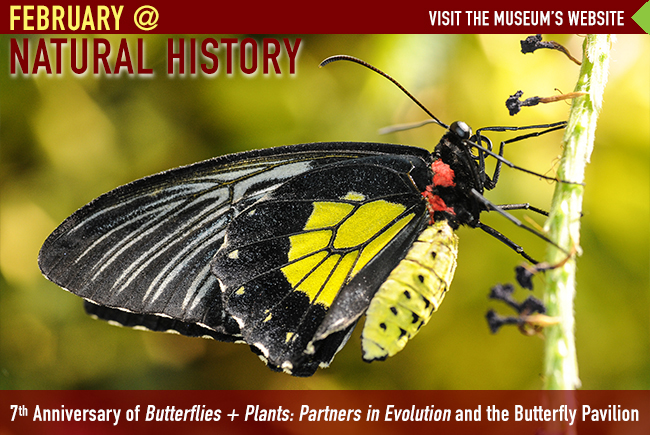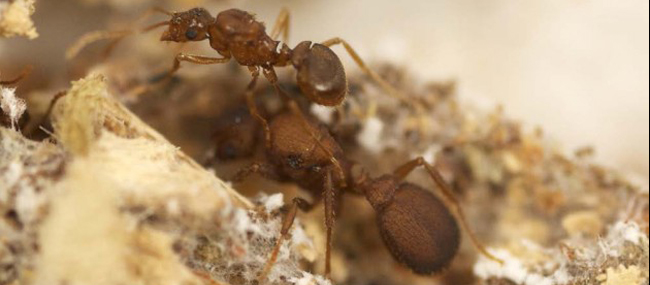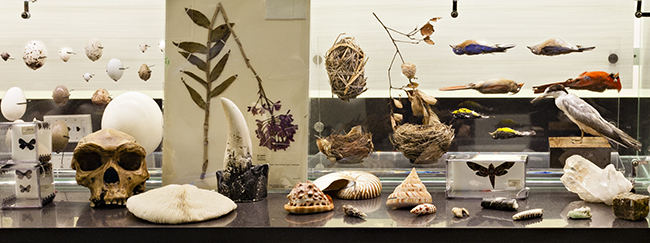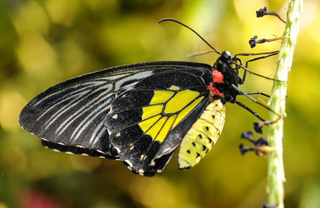| VIEW THIS EMAIL IN YOUR BROWSER > |
 |
 |
|

|
Butterflies + Plants: Partners in Evolution and the Live Butterfly Pavilion
|
SKIN & BONES: A New Mobile App for the Bone Hall
|
Come in from the cold and take a stroll among hundreds of butterflies and plants in our tropical oasis. The Live Butterfly Pavilion has re-opened, with new plants and butterflies -- just in time for its seventh anniversary on Valentine's Day!
More >
|
This must-have app interacts with skeletons to make astonishing things happen in 3D and the activities and videos can be played anywhere.
Read more >
Download the Skin & Bones App >
|
| MORE EXHIBITS > |
 |

Backstitch, Annet Couwenberg, 2014.
|
The Skeleton and the Skin
|
Restoring a Lost Ecosystem? |
Annet Couwenberg is a fiber artist whose artwork is based on the concept of clothing as a metaphor for examining the precarious balance between the body/skeleton and the outer membrane/skin.
Lynne Parenti studies the comparative anatomy and distribution of tropical freshwater and coastal marine fishes mainly from Southeast Asia.
Annet and Lynne worked together during the summer of 2014 for a unique Fellowship experience studying the Division of Fishes' collections through the lenses of both art and science. Join them as they exhibit their work and discuss what they discovered and how they learned from each other.
Sunday, February 22, 2:00 p.m.
Q?rius Theater, Ground Floor
Learn more and register >
|
Twelve thousand years ago, elephants, lions and camels roamed North
America. These and other animals went extinct in just a few thousand
years--about when humans arrived on the continent.
How did this loss influence North American landscapes? Would
reintroducing large mammals restore important ecosystem functions? Join
Harry Greene and Kate Lyons to discuss how understanding the past
changes our perspective on environmental conservation, restoration and
management.
Part of the series, "Anthropocene: Life in the Age of Humans."
Thursday, February 19, 6 - 7:30 p.m.
Q?rius Theater, Ground Floor
Learn more and register >
|
| MORE EVENTS > |
 |

|
Live Webcast -- Global Change: Reading Ocean Fossils
|
Meet Smithsonian Scientists at Free Drop-in Public Programs
|
Meet Brian Huber, paleobiologist at the National Museum of Natural History. Take a journey with him to find out how microscopic ocean organisms (forams) can tell stories about conditions on Earth millions of years ago. Consider what Brian's findings suggest for future conditions, including global climate.
Thursday, February 12, at 11 a.m. and 2 p.m. EST
Learn more >
View the webcast live at qrius.si.edu/live >
|
Daily programs bring our experts out of the field and into the exhibit halls and Q?rius, our new interactive space designed with teens in mind, to answer your questions about all things natural history. Check out the Q? Blog or Upcoming Events Calendar for program information. Our scientists are waiting to meet you.
Learn more in the Q?rius Blog >
Upcoming Events Calendar > |
| MORE EDUCATIONAL PROGRAMS > |
 |

A queen of the parasitic “Mycocepurus castrator” rides on the queen of its host species “M. goeldii." Photo by Scott Solomon.
|
Ant Species Branched Off as Parasite in Its Own Colony
|
Digitizing the National Entomological Collection |
A research team including Smithsonian entomologist Ted Schultz recently discovered a species of ant that supports a controversial theory of species formation. The species of parasitic ant branched off from its original species while living in the same colony.
Read more >
|
With over 35 million specimens, the National Entomological Collection is one of the largest insect collections in the world. Staff and volunteers are working to make the collection accessible to anyone with an internet connection, by sharing specimen data and photographs online.
Read more > |
| MORE RESEARCH > |
 |

Collections Wall in Q?rius. Photograph by James DiLoreto, Smithsonian Institution.
|
| Support the Museum Today |
Volunteer Opportunities in the Insect Zoo and Butterfly Pavilion
|
Your contributions help fund education outreach to schools, updates to exhibition halls, fellowship opportunities for young scientists, and scientific research expeditions.
Learn more about the many ways you can help support your National Museum of Natural History. >
Make a gift today! >
|
Come join a team of Insect Ambassadors at the Insect Zoo and Butterfly Pavilion! Share your interest in insects and the natural world with the Museum's diverse visitors. Within these exhibits, you'll find several hundred tropical butterflies and more than 50 species of arthropods from all over the world.
Learn about volunteer opportunities > |
| MORE WAYS TO GET INVOLVED > |

|
BANNER IMAGE:
Southern Birdwing Butterfly (Troides minos). Photograph by Rosa Pineda, Smithsonian Institution. From the Live Butterfly Pavilion within the exhibition, Butterflies + Plants: Partners in Evolution.
To view more photos, visit the Butterfly Pavilion + Insect Zoo Facebook page > |
|
|
© 2015 Smithsonian's National Museum of Natural History
10th St. and Constitution Ave., NW | Washington, DC 20013 |
CHANGE EMAIL PREFERENCES > |
|